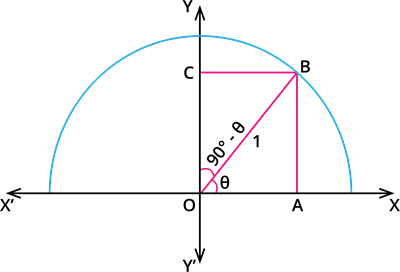PDF chapter test TRY NOW
| \sin (90^\circ - \theta) = \cos \theta | \cos (90^\circ - \theta) = \sin\theta |
| \tan (90^\circ - \theta) = \cot \theta | \cot (90^\circ - \theta) = \tan \theta |
| \text{cosec} (90^\circ - \theta) = \sec \theta | \sec (90^\circ - \theta) = \text{cosec}\: \theta |
Visual proof of Trigonometric complementary angle
Let us consider a semicircle of radius 1 unit.
Assume \angle BOA = \theta and radius = OB = 1.
\Rightarrow \angle BOC = 90^\circ - \theta.
\Rightarrow OABC forms a rectangle.

Consider a triangle OAB:
\cos \theta = \frac{\text{Adjacent side to}\ \theta}{\text{Hypotenuse}}
\cos \theta = \frac{OA}{OB}
\cos \theta = \frac{OA}{1}
\cos \theta = OA - - - - - (I)
Similarly, \sin \theta = \frac{\text{Opposite side to}\ \theta}{\text{Hypotenuse}}
\sin \theta = \frac{AB}{OB}
\sin \theta = \frac{AB}{1}
\sin \theta = AB - - - - - (II)
Consider a triangle BOC:
\cos (90^\circ - \theta) = \frac{\text{Adjacent side to}\ (90^\circ - \theta)}{\text{Hypotenuse}}
\cos (90^\circ - \theta) = \frac{OC}{OB}
\cos (90^\circ - \theta) = \frac{OC}{1}
\cos (90^\circ - \theta) = OC - - - - - (III)
Similarly, \sin (90^\circ - \theta) = \frac{\text{Opposite side to}\ (90^\circ - \theta)}{\text{Hypotenuse}}
\sin (90^\circ - \theta) = \frac{BC}{OB}
\sin (90^\circ - \theta) = \frac{BC}{1}
\sin (90^\circ - \theta) = BC - - - - - (IV)
Since OABC is a rectangle, opposite sides are equal.
OA = BC and AB = OC
\cos \theta = \sin (90^\circ - \theta) and \sin \theta = \cos (90^\circ - \theta).
Hence, we proved.
Important!
(\sin \theta)^2 = \sin^2 \theta
(\cos \theta)^2 = \cos^2 \theta
(\tan \theta)^2 = \tan^2 \theta
(\text{cosec}\: \theta)^2 = \text{cosec}^2\: \theta
(\sec \theta)^2 = \sec^2 \theta
(\cot \theta)^2 = \cot^2 \theta
